
Saskatchewan was the only province or territory in Canada that I had not yet visited. Of all the things that I wished to do there, Batoche was at the top of the list. Ever since I had discovered Pilons in the region's history, Batoche had been a distant destination, and now the opportunity of actually going there was presenting itself.
The meetings took place over four days. I had decided to travel to Batoche on the saturday, a day whose papers interested me less.
The weather, up to and including friday, had been just beautiful. However, the weather forecasts called for gradual clouding over on saturday morning and the possibility of showers in the afternoon. I was beginning to feel uneasy with plans that I had made for saturday. I was a bit nervous about driving in the country; there were few landmarks. Nonetheless, I left Saskatoon for Batoche in a rented vehicle around 10:30. My wife, Abbie, had wisely advised me to leave as early as possible.
The highway heading north was straight and not very interesting. I passed some small towns with their tall grain elevators standing beside the railroad tracks. Every now and then I spotted some interesting looking ducks in small ponds or lakes located beside the highway. But for the most part I didn't find the trip very exciting, but luckily it wasn't raining yet in spite of being clouded over and quite windy.
Finally I arrived at my first turn. This road led towards the South Saskatchewan River. Before crossing it, I stopped and climbed the high bank to overlook what used to be Gabriel's Crossing, where Gabriel Dumont had operated a ferry. At that moment, my imagination soared and I left 1997, reaching a more distant past. Spring flowers were shivering in the wind and the land seemed to stretch away endlessly from the high eroding banks of the river.
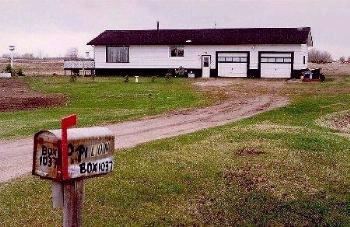 Next I
came to the road that leads to Batoche. It runs parallel to the South Saskatchewan,
cutting across the old Metis farms; those long narrow ribbons of land that
reminded me of the farms in the St.Lawrence Valley. The mail boxes spoke
the names of the region's Metis past: Venne, Parenteau, Fiddler. I said
to myself, "If I come across a mailbox with Pilon on it, I have to stop."
Then I saw one. I examined a late XIXth century map published in Diane
Payment*'s book and I was convinced that this farm house was located
on an ancestral Pilon farmstead.
Next I
came to the road that leads to Batoche. It runs parallel to the South Saskatchewan,
cutting across the old Metis farms; those long narrow ribbons of land that
reminded me of the farms in the St.Lawrence Valley. The mail boxes spoke
the names of the region's Metis past: Venne, Parenteau, Fiddler. I said
to myself, "If I come across a mailbox with Pilon on it, I have to stop."
Then I saw one. I examined a late XIXth century map published in Diane
Payment*'s book and I was convinced that this farm house was located
on an ancestral Pilon farmstead.
I drove into the yard and stopped in front of the white bungalow. A large dog barked, but luckily it was tied up. The long house had a two bay garage and like the road, it's length lay parallel to the river, which was not far away at all, but still lay hidden in it's deep valley.
As I got out of my car, I notied a lady coming to the door which had a large, inviting window. She had the door open before I got to it. I asked her if her last name was in fact Pilon and she answered that it was. I told her that mine was as well and she invited me in. We spoke in English.
Once inside, Mrs. Roberta Pilon, née Parenteau introduced me to Patrick Pilon. We shook hands and I could feel his warmth, but also a certain shyness. He was tall and dark; his Metis heritage standing proudly. We sat at the kitchen table and I was offered a cup of coffee. The home was comfortable. The combined kitchen-dinning room led to the living room which took up the whole end of the house. Sliding glass doors made the panelled walls brighten up.
We talked about family things; their parents, their history on this farm. Roberta and Patrick had lived in Vancouver and in Alberta. He was the fourth generation to grow grain here. An hour passed before I realized it and I didn't want to keep them any longer because they had been in the process of getting ready to leave for Prince Albert. I had turned into their yard at just the right time.
And then the most moving moment for me came when I asked them if they spoke French. Why of course!!! And we continued our conversation in both French and English. While they had slight English accents when they spoke French, they also had slight French accents when they spoke English!!! This linguistic link made me jump through a hole in reality.
I knew that Pilons had lived in this part of the country and here they had participated in my country's history. I also knew that the Pilons of Batoche shared a not-so-distant ancestor with me. An now I was in the kitchen of a Batoche Pilon and they still spoke French!!! It was as if I had travelled back in time over a century. I was living a dream. They brought out old photographs, pictures of his father even one of himself in his mother's arms. One of the pictures had been taken with the same studio background as a photograph of Joseph Caton Pilon and his friends that Diane Payment published in her book.
Just before leaving, we exchanged addresses. I asked if I could take their picture, but they didn't feel "dressed for it". So I left for Batoche with nothing more than wonderful memories of very charming and welcoming people.
When I arrived at the entrance of Batoche National Park, a sign at the gate indicated that the season didn't begin for nearly three weeks still. But I did not feel as much like a tourist, but rather a pilgrim!!! So I parked my car outside the gate and jumped the fence. I went to the interpretive centre as well as the large garage next door, but both were closed. So I had little choice but to visit the park alone and without permission.
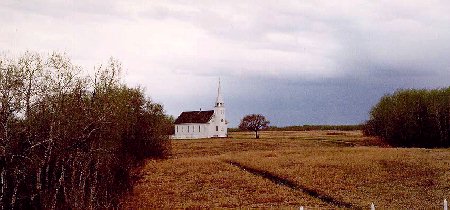 A path
led towards the small white church of Saint-Antoine de Padoue. This building
had witnessed the events of 1885, and more importantly, four generations
of Pilons were christened and married here, and had their funerals in this
church.
A path
led towards the small white church of Saint-Antoine de Padoue. This building
had witnessed the events of 1885, and more importantly, four generations
of Pilons were christened and married here, and had their funerals in this
church.
I continued walking on the wooden sidewalk that passed the old rectory. A path now led across the fields towards the former settlement of Batoche, the place where the ferry crossing the South Saskatchewan River landed and where there used to be several buildings, mostly stores, including the beautiful home of Xavier Letendre dit Batoche. Today there are only crumbling foundations of a few of these. On the way Parks Canada plaques pointed out some of the many rifle pits that the Metis had dug and in which they hid while firing on the Canadian troops in 1885. Near the rectory a sign indicated the former location of the one-room school. The wind seemed to carry sounds of children playing and laughing, and familiar words spoken with great excitment.
As I followed these paths through the long and narrow Metis fields, I played old-time tunes on my harmonica to enliven the spirits of the place, to honour the brave men who had dared to hope to find freedom along the banks of the South Saskatchewan. The grey skies, the clouds and the winds answered my questions with tangible responses.
From the church I could see the cemetery and I now headed that way. I spent nearly an hour within the small enclosure examining each and every tombstone. Three generations of Pilons lay there. But there were also many, many more names that are so dear to us, names which can be found throughout the province of Québec and in many parts of Ontario; those of our cousins and our neighbours. I couldn't help but think of the immensity of our ancestors country, at the immensity of the courage of those who came to Batoche more than a century ago in order to build a new world where the culture and language of all would be respected.
But I also had to remind myself that even if many of the names where French and that the writing on most of the headstones was French, most of the people buried here were Metis. Their mothers were of the ancient peoples of this land and the Metis represented a new breed of person in a brand new country. The emotions running through me were like bolts of lightening, one after another as if the strong winds of the day were trying to pierce my heart with the tears of this people against whom we seemed to have turned out backs.
In addition to the burials of ordinary people no different than you or I, there were two special monuments. First, there is the grave of Gabrielle Dumont, the Metis leader who was Louis Riel's lieutenant. A large boulder marks his final resting place. From there you have a good view of the South Saskatchewan River and you can still "hear the whisper of the poplar trees"**.
The other notable burial is marked by nine wooden crosses surrounded by a small wooden fence. These are the nine who fell at Batoche and who were buried in a common grave.
It was getting late and I had to keep going, but I didn't want to leave
the cemetery. The presence of these people, of their spirits, kept me there.
But I finally decided to continue along the path which brought me in front
of Jean Caron's house which is located very close
to General Middleton's camp. The camp still appears as low hummocks and
pits left by the General's army.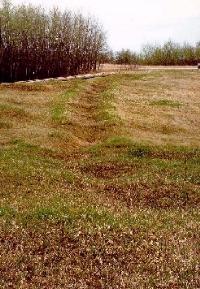 These
fortifications were based on defensive strategies developed in XIXth century
North Africa. It seemed odd to find them in the middle of the Canadian
Plains. But then it is also odd and very sad to think that the first use
of a machine-gun on human beings took place here as well.
These
fortifications were based on defensive strategies developed in XIXth century
North Africa. It seemed odd to find them in the middle of the Canadian
Plains. But then it is also odd and very sad to think that the first use
of a machine-gun on human beings took place here as well.
Only once I had finished examining the remains of Middleton's camp did the rain, which had almost miraculously held off all day, begin to fall; at first only a few drops, but the darkness of the sky told me that my visit was over. As I ran to my car, I really didn't care about the rain which was pouring by now. This visit, this pilgrimage had been memorable and the rain only served to make it more so.
Since it was now three o'clock in the afternoon, and I hadn't eaten since early in the morning, I decided to go to the nearby town of St. Isidore de Bellevue to have lunch.
As I pulled into the town's only restaurant, the rain stopped falling. The restaurant shares a roof with the local francophone senior center. Outside there was a brick bread oven. Obviously Bellevue was a francophone community, but they were descendents of immigrants from Québec and thus of a different francophone stock than the Metis of Batoche, in spite of the proximity of the two communities.
And for those who would wonder, the answer is YES, I was served in French!!! The language had a heavier English accent that Roberta and Patrick Pilon had, but the young lady serving me could not have been more than 20 years old. She is part of a new generation in a changed world, yet in spite of that, she still spoke the language of her grand-father Gaudet who founded this community.
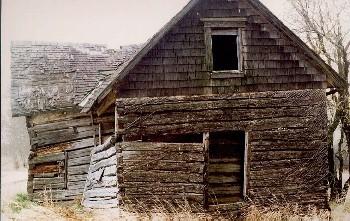 I took
the same road back to Saskatoon as I had used to come here. I wanted to
see Batoche one last time, even if only from the road. On the way, I stopped
to examine an old house near the National Park. Built of squared
timbers, the outside had been covered with diagonally
nailed tree branches which had held a kind of white-washed mortar in
place; interesting technique. Later I learned that this house might have
been built by Barthélémie Pilon.
I took
the same road back to Saskatoon as I had used to come here. I wanted to
see Batoche one last time, even if only from the road. On the way, I stopped
to examine an old house near the National Park. Built of squared
timbers, the outside had been covered with diagonally
nailed tree branches which had held a kind of white-washed mortar in
place; interesting technique. Later I learned that this house might have
been built by Barthélémie Pilon.
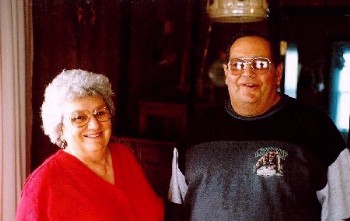 Passing
again in front of the home of Roberta and Patrick Pilon, I stopped to see
if I could take a picture of them. Luckily they agreed. We talked a bit
more and I even had a taste of some homemade Pilon wine! Was this part
of time-honoured tradition?
Passing
again in front of the home of Roberta and Patrick Pilon, I stopped to see
if I could take a picture of them. Luckily they agreed. We talked a bit
more and I even had a taste of some homemade Pilon wine! Was this part
of time-honoured tradition?
 All in
all, this day had been one of the most mystical and moving that I have
ever experienced. Even if the link between Patrick and myself is not a
direct one, I still felt like I was among family. The places that I visited
did not seem all that strange, but I felt in oddly familiar surroundings,
even if that familiarity was distant. Moreover, I felt at home here, in
as much as this is part of my country and the landscape is marked
by the passage of my relatives, of my people. And how many
other parts of this vast continent hold similar feelings if we would only
take the time to look and to listen?
All in
all, this day had been one of the most mystical and moving that I have
ever experienced. Even if the link between Patrick and myself is not a
direct one, I still felt like I was among family. The places that I visited
did not seem all that strange, but I felt in oddly familiar surroundings,
even if that familiarity was distant. Moreover, I felt at home here, in
as much as this is part of my country and the landscape is marked
by the passage of my relatives, of my people. And how many
other parts of this vast continent hold similar feelings if we would only
take the time to look and to listen?
*Diane Paulette Payment 1990 "Les gens libres--Otipemisiwak". Batoche, Saskatchewan 1870-1930. Études en archéologie, architecture et histoire. Parks Canada, Ottawa.
**From a song by Connie Kaldor: Maria's Place/Batoche.